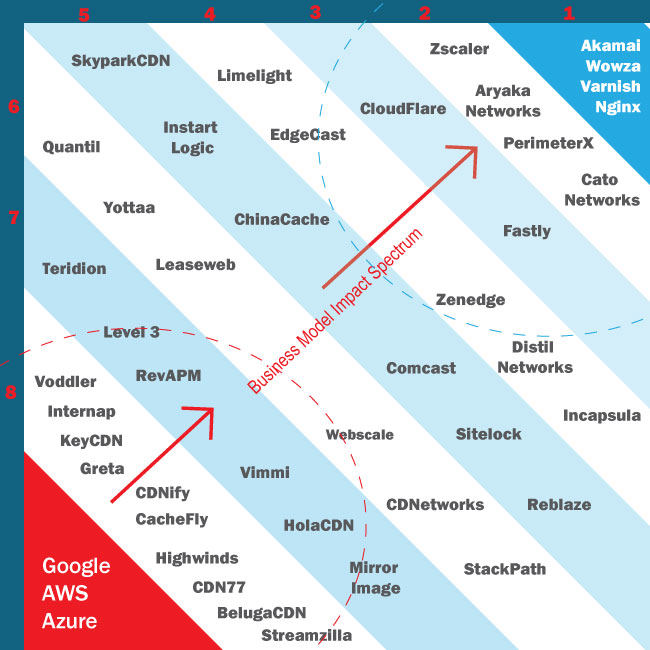In the first half of the year, the competitive landscape was in flux because new startups like PerimeterX and Cato Networks entered the market and introduced ground-breaking business models. In addition, Google officially entered the CDN market and expanded its streaming capabilities by acquiring Anvato. At the same time, AWS is investing a ton of resources into its cloud security portfolio, thus improving its WAF and DDoS Mitigation capabilities. Here is an activity snapshot for 2016:
- Cato Networks introduces the most disruptive business model in the last couple of years, which unifies an Aryaka and Zscaler like platform into one
- PerimeterX enters the market and introduces a new way for mitigating DDoS and Bot Attacks with client-side technology
- AWS is ferociously improving and building-up its WAF and DDoS Mitigation capabilities
- Google introduces a basic CDN and acquires Anvato
- Microsoft incorporates more cloud security features into the Azure platform, in order to offer it to customers
- HolaCDN introduces a tool for monitoring/managing multi-CDNs in a video streaming environment with the use of client-side javascript
- The Cloud-Trio are giving away CDN accounts for free in order to attract new business
- Akamai and others are giving away free CDN services in some cases for the first ever in order to capture new business
However, the competitive landscape is much clearer in the 3rd quarter. We are confident in our view of where the industry is heading, especially after finding out about Akamai introducing a super-low pricing structure for its big clients. That in itself is the most disruptive action taken by any company this year. We thought that the Cloud Trio would be the first to drop data transfer prices to unsustainable levels, but it was actually Akamai. In a way, Akamai took away the element of surprise away from the Cloud Trio. And rest assured, it will be a matter of time before the Cloud Trio matches Akamai’s price point and a price war surfaces in the industry. This in turn will force a few companies to exit the industry because they lack economies of scale when it comes to media delivery.
Why does the action of Akamai and the Cloud Trio dropping data transfer prices to unsustainable levels matter to Edge Security CDN companies and Cloud WAN? Because pure-play CDNs have no choice but to get into the Cloud Security and the Cloud-WAN segment – that is if they want to survive. Thus, we expect more startups to introduce Cloud Security and Cloud WAN products in the coming quarters.
Now we are going to take this insight and illustrate it on a diagram which we call the 8 Point Tier CDN Ranking. However, its a different kind of ranking – not where we compare one CDN to another CDN, but where we compare groups of companies and their features against other groups. And the base of comparison is the Cloud Trio. The Cloud Trio offers basic caching, streaming and cloud security services. Therefore, they will capture a big slice of the market, especially their own cloud customers with their low pricing structure and basic services.
Cloud Trio Capabilities
- Basic Caching
- Basic Streaming
- Basic WAF + DDoS Mitigation
In the diagram below, we moved the Cloud Trio from the upper corner to the bottom corner in order to show which companies have features sets most similar to AWS, Azure and Google CDN. The further away a company is from the Cloud Trio, the better position they’re in to compete against the Cloud Trio. For example, Level 3 and Highwinds are basically in trouble at this point. At the other end, Zscaler, Cato Networks, Akamai and Varnish are in a much better position to compete against the Cloud Trio. In fact, at this point, they really don’t need to worry about the Trio because their business models are very different. However, that doesn’t mean these companies should become complacent and fail to innovate.

The good news is we are keeping track of all companies in this diagram and ecosystem. Therefore, when events happen in the future, such as an acquisition or change in business model, we can compare it to our present day research to see how we did. For example, just recently, a new CDN entered the space by the name of BelugaCDN. Their core message is they offer $0.01/GB on data transfer and are “the lowest cost CDN on the planet”. Well, that is simply not the case. In fact, they are five times higher in price than Akamai’s $0.002/GB. Thus, BelugaCDN entering the market is what you call “Dead on Arrival”. There is just no way they are going to make it long term.
Innovators of the Market
The companies in Tiers 1, 2, and 3 are the innovators of the space. Wowza, Varnish and Nginx transformed themselves from open source tools to juggernauts that power the CDN platforms (internal & external) around the world. Zscaler, PerimeterX, Cato Networks and Aryaka have introduced new and exciting business models that are rapidly replacing the legacy models of MPLS and appliance-based security. And Fastly and CloudFlare built a volume business on edge security and high performance, by being different than everyone else.
In closing, keep in mind that we’ll continue to improve the 8 Tier CDN Ecosystem Ranking diagram as time goes by. So far, we’ve made tremendous progress over the last two weeks. And the diagram is tailored for Service Providers and CDN’s – not CDN Buyers.

